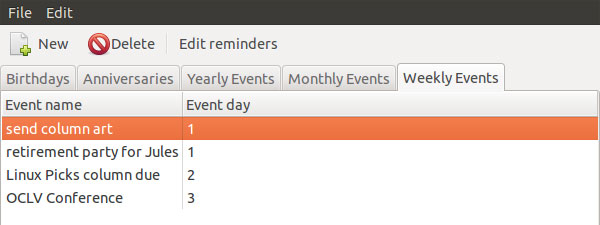
![]()

Technology growth has a subtle way of turning useful apps into obsolete solutions. For instance, Web-based services like Google Calendar, Remember the Milk and the FireFox Web browser add-on ReminderFox go a long way to rendering unnecessary standalone apps to send reminders to your computer desktop.
Adding to the obsolescence of desktop-bound apps is the roll of email push services that bring reminders and even complete To-Do Lists right to my smartphone.
Still, despite these newer technology alternatives to scribbling a real post-it note to the keyboard of monitor periphery, I find that I am still tethered to Email-Reminder. This app is a long-time favorite that sends me an email reminder to my computer screen.
Do not mistake this app for the similar-sounding Web-based reminder service. Email Reminder is a small, simple program that does not require the added layers imposed by Web-based services. I do not have to log onto a server to set up and send reminder messages. I just call up the app on my computer and enter the task. It shows up in my email in-box.
Of course, I still have to go to my email to see the reminder message. But related technology kicks in to make me aware of the reminder note. For example, a notification flags my attention on the desktop while I’m working. And I wear redundancy on my belt courtesy of the tone that sounds on my smartphone when an email message arrives, whether I am sitting at the computer screen or am out of the office.
Better Than Cryptic
I’m sure hardcore Linux buffs will scoff at app-produced reminder solutions offered by the likes of Email-Reminder. But I much prefer the ease of using the interface in Email Reminder over the awkwardness of typing command-line codes into a terminal box.
The Linux desktop GUI (Graphical User Interface) has come too far. It makes little sense to me to resort to arcane terminal commands just to get a reminder. That only kills the user-friendly notion that Linux should broadcast.
For example, I could get a reminder sent from my computer to my email or to a pop-up box by opening a terminal window and entering an “at>” command. Of course, I’d have to include strings for date and time and remember to place the reminder text in quotation marks.
By why resort to such early Unix-like stuff? Email-Reminder makes all of that so passe on today’s Linux desktop.
What It Does
Email-reminder makes it easy to enter events for reminder messages through email. This lets you get reminder notes about upcoming birthdays, anniversaries and yearly events. The app lets you schedule a reminder to be received on the day of the event or a few days beforehand.
The Email-Reminder package includes Cron job. Cron is a time-based job scheduler built into the Linux operating system. Cron lets users schedule jobs to run at certain times or dates.
The Email-Reminder app checks for events and sends reminders. It takes no configuration. Plus, its simple GUI makes it easy to create and edit reminders your way.
Look and Feel
Some other Linux packages such as KAlarm have alarm components that resemble the reminder functionality that Email-Reminder provides. And you can also find several alarm-type apps that sound an alarm and pop up a note at a specified time.
The GUI that Email-Reminder uses is much simpler than typically found in other apps. Besides not needing much in the way of configuration settings, it offers only three preference options.
You can set the default recipient’s name for the reminder emails. You can set the email address. And you can elect to send birthday wishes to the email-reminder author. This last choice is better left unchecked.
The File menu gives you a test configuration command. All this really does is check to see that the app works on your system. You cannot alter anything if it fails this test. The Edit menu offers the same functions as the button in the second row: New, Delete and Edit Reminders.
Fixing It
If the configuration test fails, no doubt the cause is restricted permission in your Linux OS settings. If your log-in is anything other than the admin, Email-Reminder may be denied access to sending the email notice.
To fix this problem, go to /usr/bin/send-reminders file. Right click on the file name and select the permissions tab under the properties options.
If you cannot alter the permissions there, go to Systems/Administration/Users and Groups to change your user settings. At least that was the location for the access in my Ubuntu 11.04 configuration.
Using It
The app interface show a row of tabs for each type of reminder you can set. The list includes Birthdays, Anniversaries, Yearly Events, Monthly Events and Weekly Events.
Click the event category button and then click the New Event button. The label New Event appears in carrots. Click in that field to enter an event name. Depending on the type of reminder category you select, one or more fields will appear, such as person’s name, date and email address.
The Edit Reminders menu button on row two lets you select a check box to send the reminder for the same day or for a specified number of days in advance.
Clicking the Close button saves the entry. That is all it takes to use Email-Reminder.
Bottom Line
Email-Reminder almost seems overly simplistic. It is an old-fashioned approach to sending yourself important reminders. It isn’t linked to a feature buried within a calendar or contact database. So it truly runs as a stand-alone reminder solution.
It is minimalistic strategy at its finest. The only other option I would like see this app handle is the ability to place a reminder notification on the desktop. Either way, sending the reminder as an email alert solves the problem of using multiple computers.
Unlike other reminder apps, Email-Reminder is not restricted to a single computer. The email alerts find you wherever your email connection lives.




















































